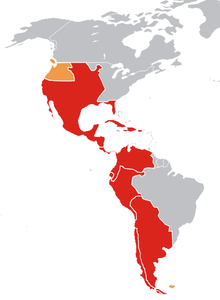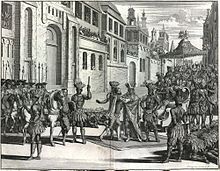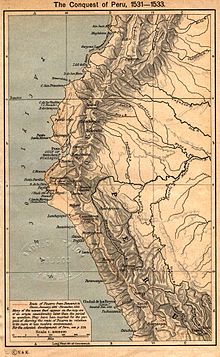- Spanish colonization of the Americas
-
"Conquista" redirects here. For other uses, see Conquista (disambiguation).
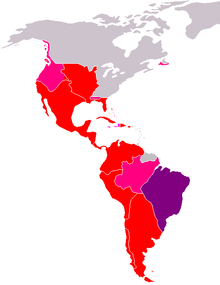 Farthest extent of Spanish colonization in America.
Farthest extent of Spanish colonization in America.
Red: Farthest extent of Spanish colonies under the House of Bourbon in the 1790s.
Pink: Disputed claims of Spanish colonial administration.
Purple: Portuguese colonies under dual Spanish colonial administration- conquest, settlement and political rule over much of the Western HemisphereColonial expansion under the Spanish Empire was initiated by the Spanish conquistadores and developed by the Monarchy of Spain through its administrators and missionaries. The motivations for colonial expansion were trade and the spread of the Christian faith through indigenous conversions. It lasted for over four hundred years, from 1492 to 1898.
Beginning with the 1492 arrival of Christopher Columbus, over nearly four centuries the Spanish Empire would expand across: most of present day Central America, the Caribbean islands, and Mexico; much of the rest of North America including the Southwestern, Southern coastal, and California Pacific Coast regions of the United States; and though inactive, with claimed territory in present day British Columbia Canada; and U.S. states of Alaska, Washington, and Oregon; and the western half of South America.[1][2][3] In the early 19th century the revolutionary movements resulted in the independence of most Spanish colonies in America, except for Cuba and Puerto Rico, given up in 1898 following the Spanish-American War, together with Guam and the Philippines in the Pacific. Spain's loss of these last territories politically ended Spanish colonization in America. The cultural influences, though, still remain.
Contents
Exploration
European colonization
of the AmericasFirst colonization British colonization Courlandish colonization Danish colonization Dutch colonization French colonization German colonization Norse colonization Portuguese colonization Russian colonization Scottish colonization Spanish colonization Swedish colonization Colonization of Canada Colonization of the USA Decolonization Christopher Columbus
Main article: Christopher ColumbusSince the early 15th century, Portuguese explorers, sailing in caravels, had established new southward routes to Asia, by travelling along the coast of West Africa. In 1488, they rounded the Cape of Good Hope and explored East Africa; later, they discovered rich trading regions in Indonesia, and established trading ports on the western coast of Indonesia, and later India. In 1485, Christopher Columbus unsuccessfully tried to persuade King John II of Portugal (João II) to sponsor an expedition to Asia, meant to be reached by sailing westwards, across the Atlantic Ocean. That alternative route, different from the theoretical eastward route, was based on the conviction that the Earth was round. The Portuguese Court rejected that proposal because they believed that the distance to Asia was greater than what Columbus had calculated; in 1488, Columbus re-presented his plan to John II of Portugal, who refused him, based on the recent discovery, by Bartholomeu Dias, of the eastward route to Asia along the African coast and across the Indian Ocean.
Undeterred, Columbus went to the Spanish Court, where he proved more persuasive with the Catholic Monarchs, the recently enthroned Isabella I Queen of Castile and her husband Ferdinand II King of Aragon. Although Columbus had presented his navigational plan to the Spanish Court as early as 1486, proposing to reach Asia by sailing West, across the Atlantic Ocean, he was unconvincing to the Catholic Monarchs until 1491, when Queen Isabella approved it. In August 1492, Columbus sailed from the Andalusian port of Palos de la Frontera in Southern Spain, and arrived on the island of Guanahani, in the Bahamas, on 12 October 1492. On that first trans-Atlantic voyage, Columbus and his sailors were greeted by the Arawak people of the Bahamas, who were kind and curious about the Spanish sailors, and offered food, water, and gifts. Yet, in his log, Columbus wrote that “. . . They would make fine servants . . . With fifty men we could subjugate them all, and make them do whatever we want.” In 1495, Columbus and crew rounded up 1,500 Arawak men, women, and children, from which group they selected 500 “best specimens” to take to his sponsors; of those people, some 200 died en route to Spain.[4] At the Spanish Court, Columbus presented the Catholic Monarchs, Ferdinand and Isabel, with the captured Arawaks, gold trinkets, parrots, and other exotic things. Impressed with the human and material bounties yielded by the first expedition, they commissioned Columbus for a second expedition, and provided 17 ships, some 1,500 soldiers, cavalry, and weapons (cannon, crossbows, guns, and attack dogs). In 1493, Columbus returned to the New World and claimed Spanish ownership of the island of Hispaniola (contemporary Haiti and the Dominican Republic) from the indigenous Taíno people.[citation needed] The Spanish Monarchs granted Columbus the governorship of the new territories, and financed more of his trans-Atlantic journeys. Although considered an excellent navigator, Columbus wrecked the Santa María, the flagship of his fleet; he proved a poor administrator and was stripped of the governorship in 1500; he was jailed for six weeks upon returning to Spain; yet Ferdinand and Isabel financed his fourth voyage to the New World, but denied him the governorship of the land.[citation needed]
As a businessman of his time, Christopher Columbus profited from the agricultural and gold-mining labour of native slaves; he took back to Europe some 500 American natives whom he tried to sell as slaves in Spain.[citation needed] In the New World, the Taíno people began resisting their Spanish enslavement; they refused to plant crops, and abandoned their Spanish-occupied villages; their rebellion progressed from disobedience to violence, and they fought the Spanish invaders with guerrilla warfare, such as booby traps, ambushes, and attrition warfare to exhaust the Spanish soldiers. Although stone arrowheads could not penetrate the armour of the Spanish soldier, they were effective as shrapnel against the breast plates of the soldiers; however, stone and copper maces proved more effective in close combat; yet it was the sling that proved most effective, because the rocks hurled could readily crush an armoured cavalryman (caballero).[5] In 1522, the Taíno Cacique Enriquillo (Little Henry) successfully rebelled against Spanish rule, forcing them to agree to a treaty that granted the natives the human rights of Freedom and of Possession; yet that forced concession proved inconsequential, because European diseases, slavery, and ritual infanticide and suicide (meant to avoid adult and infantile enslavement) quickly killed most of the Taíno people.[citation needed]
In 1502, on the fourth, and final, expedition to the American continent, Christopher Columbus encountered a large canoe, filled with goods, off the coast of Honduras; after boarding it, he found cacao beans, axes with heads of copper and of flint, bells, pottery, and cotton garments — it was the first Spanish encounter with the civilisations of Central America.[citation needed]
First mainland explorations
In 1513, Vasco Núñez de Balboa crossed the Isthmus of Panama, to find gold but instead led the first European expedition to the Pacific Ocean and the west coast of the New World. In an action with enduring historical import, Balboa claimed the Pacific Ocean and all the lands adjoining it for the Spanish Crown. It was 1517 before another expedition from Cuba explored Central America. It landed on the coast of the Yucatán peninsula in search of slaves.
Conquests
The Caribbean: First settlements in America
Main article: Spanish conquest of the Chibchan NationsThe first mainland explorations were followed by a phase of inland expeditions and conquest. The Spanish crown extended the Reconquista effort, completed in Spain in 1492, to non-Catholic people in new territories. In 1502 on the coast of present day Colombia, near the Gulf of Urabá, Spanish explorers led by Vasco Núñez de Balboa explored and conquered the area near the Atrato River. The conquest was of the Chibchan speaking nations, mainly the Muisca and Tairona indigenous people that lived here. The Spanish founded San Sebastian de Uraba in 1509—abandoned within the year, and in 1510 the first permanent Spanish mainland settlement in America, Santa María la Antigua del Darién. [6] These were the first European settlements in America. The conquistadors were truly amazed by what they found — immense wealth in gold and silver, complex cities rivaling or surpassing those in Europe, and remarkable artistic and scientific achievements. Spanish conquest in the New World was driven by the three 'G's—God, glory, and gold. [7][8][9]
Mexico
Main articles: Spanish conquest of Mexico and Spanish conquest of YucatánThere is a difference in the 'Spanish conquest of Mexico' between the Spanish conquest of the Aztec Empire and the Spanish conquest of Yucatán. The former is conquest of the campaign, led by Hernán Cortés from 1519–21 and his Tlaxcala and other 'indigenous peoples' allied against the Mexica/Aztec empire. The Spanish conquest of Yucatán is the much longer campaign, from 1551–1697, against the Maya peoples of the Maya civilization in the Yucatán Peninsula of present day Mexico and northern Central America. The day Hernán Cortés landed ashore at present day Veracruz, April 22, 1519, marks the beginning of 300 years of Spanish hegemony over the region.
Peru
Main article: Spanish conquest of the Inca EmpireIn 1532 at the Battle of Cajamarca a group of Spanish soldiers under Francisco Pizarro and their indigenous Andean Indian auxiliaries native allies ambushed and captured the Emperor Atahualpa of the Inca Empire. It was the first step in a long campaign that took decades of fighting to subdue the mightiest empire in the Americas. In the following years Spain extended its rule over the Empire of the Inca civilization.
The Spanish took advantage of a recent civil war between the factions of the two brothers Emperor Atahualpa and Huáscar, and the enmity of indigenous nations the Incas had subjugated, such as the Huancas, Chachapoyas, and Cañaris. In the following years the conquistadors and indigenous allies extended control over the greater Andes region. The Viceroyalty of Perú was established in 1542.
Río de la Plata and Paraguay
European explorers arrived to Río de la Plata in 1516. Their first Spanish settlement in modern this zone was the Fort of Sancti Spiritu established in 1527 next to the Paraná River. Buenos Aires, a permanent colony, was established in 1536 and in 1537 Asunción was established in the area that is now Paraguay. Buenos aires suffered attacks by the indigenous peoples that forced the settlers away, and in 1541 the site was abandoned. A second (and permanent) settlement was established in 1580 by Juan de Garay, who arrived by sailing down the Paraná River from Asunción (now the capital of Paraguay). He dubbed the settlement "Santísima Trinidad" and its port became "Puerto de Santa María de los Buenos Aires." The city came to be the head of the Governorate of the Río de la Plata and in 1776 elevated to be the capital of the new Viceroyalty of the Río de la Plata.
Governing
Spain's administration of its colonies in the Americas was divided into the Viceroyalty of New Spain 1535 (capital, México City), and the Viceroyalty of Peru 1542 (capital, Lima). In the 18th century the additional Viceroyalty of New Granada 1717 (capital, Bogotá), and Viceroyalty of Rio de la Plata 1776 (capital, Buenos Aires) were established from portions of the Viceroyalty of Peru.
This evolved from the Council of the Indies and Viceroyalties into an Intendant system, in an attempt for more revenue and efficiency.
19th century
Main article: Spanish American wars of independenceDuring the Peninsular War in Europe between France and Spain, assemblies called juntas were established to rule in the name of Ferdinand VII of Spain. The Libertadores (Spanish and Portuguese for "Liberators") were the principal leaders of the Latin American wars of independence from Spain. They were predominantly criollos (local-born people of European, mostly of Spanish or Portuguese, ancestry), bourgeois and influenced by liberalism and in most cases with military training in the mother country.
In 1809 the first declarations of independence from Spanish rule occurred in the Viceroyalty of New Granada. The first two were in present day Bolivia at Sucre (May 25), and La Paz ( July 16); and the third in present day Ecuador at Quito (August 10). In 1810 Mexico declared independence, with the Mexican War of Independence following for over a decade. In 1821 Treaty of Córdoba established Mexican independence from Spain and concluded the War. The Plan of Iguala was part of the peace treaty to establish a constitutional foundation for an independent Mexico.
These began a movement for colonial independence that spread to Spain's other colonies in the Americas. The ideas from the French and the American Revolution influenced the efforts. All of the colonies, except Cuba and Puerto Rico, attained independence by the 1820s. The British Empire offered support, wanting to end the Spanish monopoly on trade with its colonies in the Americas.
In 1898, the United States won victory in the Spanish-American War from Spain, ending the colonial era. Spanish possession and rule of its remaining colonies in the Americas ended in that year with its ownership transfer to the United States. The U.S. took occupation of Cuba, the Philippines, and Puerto Rico. The latter possession now officially continues as a self-governing unincorporated territory of the United States.
Demographic impact
It has been estimated that in the 16th century about 240,000 Spaniards emigrated to America, and in the 17th century about 500,000, predominantly to Mexico and Peru.[10]
Before the arrival of Columbus, in Hispaniola the indigenous Taíno pre-contact population of several hundred thousand declined to sixty thousand by 1509. Although population estimates vary, Father Bartolomé de las Casas, the “Defender of the Indians” estimated there were 6 million (6,000,000) Taíno and Arawak in the Caribbean at the time of Columbus's arrival in 1492.[citation needed]
The population of the Native Amerindian population in Mexico declined by an estimated 90% (reduced to 1 - 2.5 million people) by the early 17th century. In Peru the indigenous Amerindian pre-contact population of around 6.5 million declined to 1 million by the early 17th century.[citation needed]
Of the history of the indigenous population of California, Sherburne F. Cook (1896–1974) was the most painstakingly careful researcher. From decades of research he made estimates for the pre-contact population and the history of demographic decline during the Spanish and post-Spanish periods. According to Cook, the indigenous Californian population at first contact, in 1769, was about 310,000 and had dropped to 25,000 by 1910. The vast majority of the decline happened after the Spanish period, in the Mexican and U.S. periods of Californian history (1821–1910), with the most dramatic collapse (200,000 to 25,000) occurring in the U.S. period (1846–1910).[11][12][13]
Cultural impact
Main article: Spanish missions in the AmericasThe Spaniards were committed, by Vatican decree, to convert their New World indigenous subjects to Catholicism. However, often initial efforts were questionably successful, as the indigenous people added Catholicism into their longstanding traditional ceremonies and beliefs. The many native expressions, forms, practices, and items of art could be considered idolatry and prohibited or destroyed by Spanish missionaries, military, and civilians. This included religious items, sculptures, and jewelry made of gold or silver, which were melted down before shipment to Spain.
Though the Spanish did not impose their language to the extent they did their religion, some indigenous languages of the Americas evolved into replacement with Spanish, and lost to present day tribal members. When more efficient they did evangelize in native languages. Introduced writing systems to the Quechua, Nahuatl and Guarani peoples may have contributed to their expansion.[citation needed]
See also
References
- ^ "Presencia Hispánica en la Costa Noroeste de América (Siglo XVIII)" (PDF). http://cvc.cervantes.es/obref/aih/pdf/03/aih_03_1_013.pdf. Retrieved 2011-09-04.
- ^ Study of the Fundació d'Estudis Històrics de Catalunya[dead link]
- ^ "Source in Spanish". Cesarfrijol.tripod.com. http://cesarfrijol.tripod.com/virreynato.html. Retrieved 2011-09-04.
- ^ Zinn, Howard (2003). A People's History Of The United States. New York: The New Press. p. 281. ISBN 978-1-56584-724-8.
- ^ Jane Penrose. Slings in the Iron Age. http://books.google.ca/books?id=99haLasvV3gC&pg=PA139&lpg=PA139&dq=iron+helmet+sling&source=bl&ots=2fyIqj6k1u&sig=YXnWKDeXFwg5nHVjvwcutVDbTlU&hl=en&ei=-9YqTKXFBcP-8AaLq8jUCA&sa=X&oi=book_result&ct=result&resnum=7&ved=0CCYQ6AEwBg#v=onepage&q&f=false. Retrieved 30 June 2010.
- ^ [1][dead link]
- ^ "Spanish Discovery and Colonization". U-s-history.com. 2011-08-17. http://www.u-s-history.com/pages/h436.html. Retrieved 2011-09-04.
- ^ "CAPÍTULO XXI | banrepcultural.org". Lablaa.org. http://www.lablaa.org/blaavirtual/historia/equinoccial_2_vivienda/cap21.htm. Retrieved 2011-09-04.
- ^ [2][dead link]
- ^ "Migration to Latin America". Let.leidenuniv.nl. http://www.let.leidenuniv.nl/history/migration/chapter53.html. Retrieved 2011-09-04.
- ^ Baumhoff, Martin A. 1963. Ecological Determinants of Aboriginal California Populations. University of California Publications in American Archaeology and Ethnology 49:155-236.
- ^ Powers, Stephen. 1875. "California Indian Characteristics". Overland Monthly 14:297-309. on-line
- ^ Cook's judgement on the effects of U.S rule upon the native Californians is harsh: "The first (factor) was the food supply... The second factor was disease. ...A third factor, which strongly intensified the effect of the other two, was the social and physical disruption visited upon the Indian. He was driven from his home by the thousands, starved, beaten, raped, and murdered with impunity. He was not only given no assistance in the struggle against foreign diseases, but was prevented from adopting even the most elementary measures to secure his food, clothing, and shelter. The utter devastation caused by the white man was literally incredible, and not until the population figures are examined does the extent of the havoc become evident."Cook, Sherburne F. 1976b. The Population of the California Indians, 1769-1970. University of California Press, Berkeley|p. 200
Further reading
- David A. Brading, The First America: The Spanish Monarchy, Creole Patriots, and the Liberal State, I492-1867 (Cambridge: Cambridge University Press, 1993).
- María M. Portuondo, Secret Science: Spanish Cosmography and the New World (Chicago, Chicago UP, 2009).
External links
- Spanish Exploration and Conquest of North America
- Spain in America (Edward Gaylord Bourne, 1904) 'Spain in America'
- The Spanish Borderlands (Herbert E. Bolton, 1921) 'The Spanish Borderlands'
- Indigenous Puerto Rico DNA evidence upsets established history
Spanish Empire Administrative Institutions Viceroyalties Audiencias Captancies General Chile · Cuba · Guatemala · Spanish East Indies · Puerto Rico · Santo Domingo · Venezuela · Yucatán ˑ Provincias InternasGovernorates  History of the Americas
History of the AmericasHistory North America · Mesoamerica · Central America · Caribbean · Latin America · South America · Genetics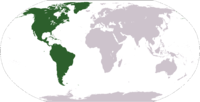
Settlement Indigenous peoples · Indigenous population · Pre-Columbian trans-oceanic contact · Discovery · Exploration · European colonization · Spanish colonization · French colonization · Portuguese colonization · British colonization · Columbian Exchange · DecolonizationSocieties Related Lists Chronology Archaeology of the Americas · North America by period · North American timelines · Mesoamerica by period · Mesoamerica timelineEra: By period · By region · Three-age system · Ancient history · Pre-Columbian · Classical Antiquity · Middle Ages · Modern history · Future Categories:- Spanish colonization of the Americas
- Colonial Mexico
- Colonial United States (Spanish)
- Colonization of the Americas
- Former empires
- Former Spanish colonies
- History of indigenous peoples of the Americas
- New Spain
- Spanish conquests in the Americas
- Viceroyalty of Peru
- 1525 establishments
- 1821 disestablishments
Wikimedia Foundation. 2010.

